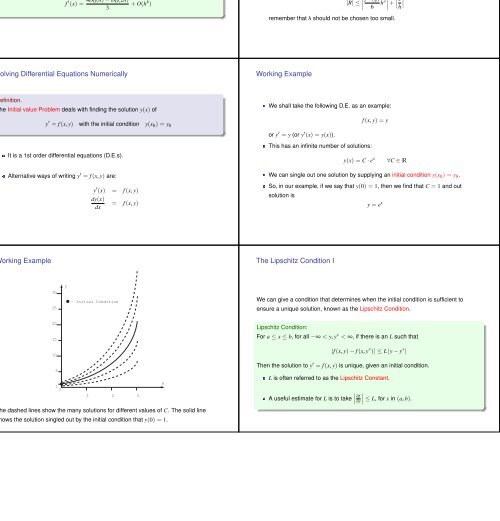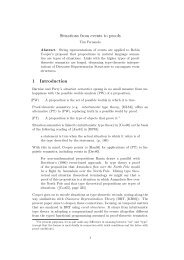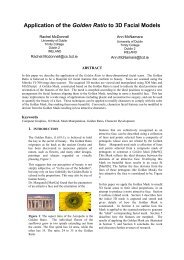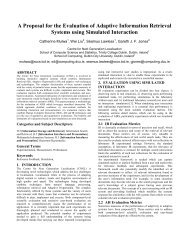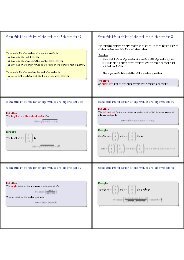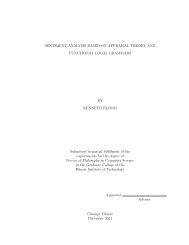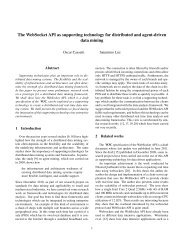Numerical Differentiation First Derivative Second Derivative Error ...
Numerical Differentiation First Derivative Second Derivative Error ...
Numerical Differentiation First Derivative Second Derivative Error ...
You also want an ePaper? Increase the reach of your titles
YUMPU automatically turns print PDFs into web optimized ePapers that Google loves.
Richardson Extrapolation III<br />
Summary<br />
It is an estimate for f ′ (x) whose truncation error is O(h 4 ), and so is an<br />
improvement over D 0 used alone.<br />
This technique of using calculations with different h values to get a better estimate<br />
is known as Richardson Extrapolation.<br />
Richardson’s Extrapolation.<br />
Suppose that we have the two approximations D 0 (h) and D 0 (2h) for f ′ (x), then an<br />
improved approximation has the form:<br />
f ′ (x) = 4D 0(h) − D 0 (2h)<br />
+ O(h 4 )<br />
3<br />
Approximation for numerical differentiation:<br />
Approximation for f ′ (x)<br />
<strong>Error</strong><br />
Forward/backward difference D + , D − O(h)<br />
Central difference D 0 O(h 2 )<br />
Richardson Extrapolation O(h 4 )<br />
Considering the total error (approximation error + calculation error):<br />
|R| ≤<br />
f ′′′ ∣<br />
(ξ) ∣∣∣ ∣ h 2 + ∣ ǫ ∣<br />
6 h<br />
remember that h should not be chosen too small.<br />
Solving Differential Equations <strong>Numerical</strong>ly<br />
Working Example<br />
Definition.<br />
The Initial value Problem deals with finding the solution y(x) of<br />
y ′ = f(x, y) with the initial condition y(x 0 ) = y 0<br />
It is a 1st order differential equations (D.E.s).<br />
Alternative ways of writing y ′ = f(x, y) are:<br />
y ′ (x) = f(x, y)<br />
dy(x)<br />
dx<br />
= f(x, y)<br />
We shall take the following D.E. as an example:<br />
f(x, y) = y<br />
or y ′ = y (or y ′ (x) = y(x)).<br />
This has an infinite number of solutions:<br />
y(x) = C · e x ∀C ∈ R<br />
We can single out one solution by supplying an initial condition y(x 0 ) = y 0 .<br />
So, in our example, if we say that y(0) = 1, then we find that C = 1 and out<br />
solution is<br />
y = e x<br />
Working Example<br />
The Lipschitz Condition I<br />
y<br />
30<br />
- Initial Condition<br />
25<br />
20<br />
15<br />
10<br />
5<br />
x<br />
1<br />
0<br />
1 2 3<br />
The dashed lines show the many solutions for different values of C. The solid line<br />
shows the solution singled out by the initial condition that y(0) = 1.<br />
We can give a condition that determines when the initial condition is sufficient to<br />
ensure a unique solution, known as the Lipschitz Condition.<br />
Lipschitz Condition:<br />
For a ≤ x ≤ b, for all −∞ < y, y ∗ < ∞, if there is an L such that<br />
|f(x, y) − f(x, y ∗ )| ≤ L |y − y ∗ |<br />
Then the solution to y ′ = f(x, y) is unique, given an initial condition.<br />
L is often referred to as the Lipschitz Constant.<br />
A useful estimate for L is to take ∣ ∂f<br />
∂y∣ ≤ L, for x in (a, b).


